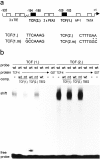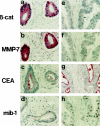beta-catenin regulates the expression of the matrix metalloproteinase-7 in human colorectal cancer
- PMID: 10514384
- PMCID: PMC1867011
- DOI: 10.1016/s0002-9440(10)65204-2
beta-catenin regulates the expression of the matrix metalloproteinase-7 in human colorectal cancer
Abstract
Most colorectal cancers have loss of function mutations in the adenomatosis polyposis coli (APC) tumor suppressor gene. This leads to accumulation of beta-catenin, which together with the DNA binding protein TCF-4 functions as a transcriptional activator. Recently defined target genes are c-myc and cyclin D1, linking the APC gene defect to the capacity for autonomous proliferation of colon tumors. Here we report the identification of the matrix metalloproteinase MMP-7 as another target gene of beta-catenin/TCF-4. MMP-7 is overexpressed in 80% of human colorectal cancers and known to be an important factor for early tumor growth, with a potential function also for later progression steps, like invasion and metastasis. Our results explain the high percentage of MMP-7 overexpression in colon tumors. Moreover they indicate that defects in the APC tumor suppressor gene may also have an influence on later steps of colon tumor progression.
Figures



Similar articles
-
[beta-Catenin induces invasive growth by activating matrix metalloproteinases in colorectal carcinoma].Verh Dtsch Ges Pathol. 2000;84:175-81. Verh Dtsch Ges Pathol. 2000. PMID: 11217438 German.
-
Identification of c-MYC as a target of the APC pathway.Science. 1998 Sep 4;281(5382):1509-12. doi: 10.1126/science.281.5382.1509. Science. 1998. PMID: 9727977
-
Beta-catenin regulates expression of cyclin D1 in colon carcinoma cells.Nature. 1999 Apr 1;398(6726):422-6. doi: 10.1038/18884. Nature. 1999. PMID: 10201372
-
Beta-catenin--a linchpin in colorectal carcinogenesis?Am J Pathol. 2002 Feb;160(2):389-401. doi: 10.1016/s0002-9440(10)64856-0. Am J Pathol. 2002. PMID: 11839557 Free PMC article. Review.
-
Wnt/beta-catenin/tcf signaling: a critical pathway in gastrointestinal tumorigenesis.Digestion. 2002;66(3):131-44. doi: 10.1159/000066755. Digestion. 2002. PMID: 12481159 Review.
Cited by
-
S100A8 and S100A9 are associated with colorectal carcinoma progression and contribute to colorectal carcinoma cell survival and migration via Wnt/β-catenin pathway.PLoS One. 2013 Apr 26;8(4):e62092. doi: 10.1371/journal.pone.0062092. Print 2013. PLoS One. 2013. PMID: 23637971 Free PMC article.
-
MMP-7, -8, -9, E-cadherin, and beta-catenin expression in 34 ameloblastoma cases.Clin Exp Dent Res. 2021 Feb;7(1):63-69. doi: 10.1002/cre2.331. Epub 2020 Sep 28. Clin Exp Dent Res. 2021. PMID: 32985799 Free PMC article.
-
Knockdown of Upregulated Gene 11 (URG11) Inhibits Proliferation, Invasion, and β-Catenin Expression in Non-Small Cell Lung Cancer Cells.Oncol Res. 2016;24(3):197-204. doi: 10.3727/096504016X14648701447850. Oncol Res. 2016. PMID: 27458101 Free PMC article.
-
Prognostic impact of the expression of Wnt-signaling proteins in cervical carcinoma FIGO stage I-IV treated with radiotherapy or chemoradiotherapy.Oncotarget. 2016 Sep 27;7(39):63042-63053. doi: 10.18632/oncotarget.11642. Oncotarget. 2016. PMID: 27577083 Free PMC article.
-
The p120(ctn)-binding partner Kaiso is a bi-modal DNA-binding protein that recognizes both a sequence-specific consensus and methylated CpG dinucleotides.Nucleic Acids Res. 2002 Jul 1;30(13):2911-9. doi: 10.1093/nar/gkf398. Nucleic Acids Res. 2002. PMID: 12087177 Free PMC article.
References
-
- Kinzler KW, Vogelstein B: Lessons from hereditary colorectal cancer. Cell 1996, 87:159-170 - PubMed
-
- Molenaar M, van de Wetering M, Oosterwegel M, Peterson-Maduro J, Godsave S, Korinek V, Roose J, Destree O, Clevers H: XTcf-3 transcription factor mediates β-catenin-induced axis formation in Xenopus embryos. Cell 1996, 86:391-399 - PubMed
-
- Morin PJ, Sparks AB, Korinek V, Barker N, Clevers H, Vogelstein B, Kinzler KW: Activation of β-catenin-Tcf signaling in colon cancer by mutations in β-catenin or APC. Science 1997, 275:1787-1790 - PubMed
-
- Korinek V, Barker N, Morin PJ, van Wichen D, de Weger R, Kinzler KW, Vogelstein B, Clevers H: Constitutive transcriptional activation by a β-catenin-Tcf complex in APC−/− colon carcinoma. Science 1997, 275:1784-1787 - PubMed
-
- He TC, Sparks AB, Rago C, Hermeking H, Zawel L, da Costa LT, Morin PJ, Vogelstein B, Kinzler KW: Identification of c-myc as a target of the APC pathway. Science 1998, 281:1509-1512 - PubMed
MeSH terms
Substances
LinkOut - more resources
Full Text Sources
Other Literature Sources
Medical
Research Materials
Miscellaneous

